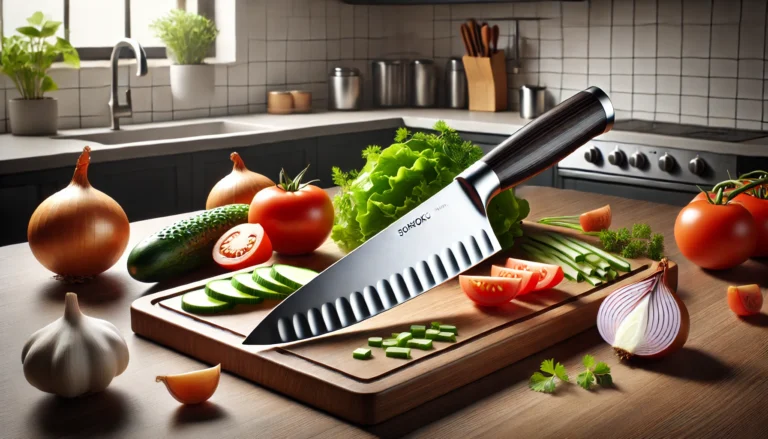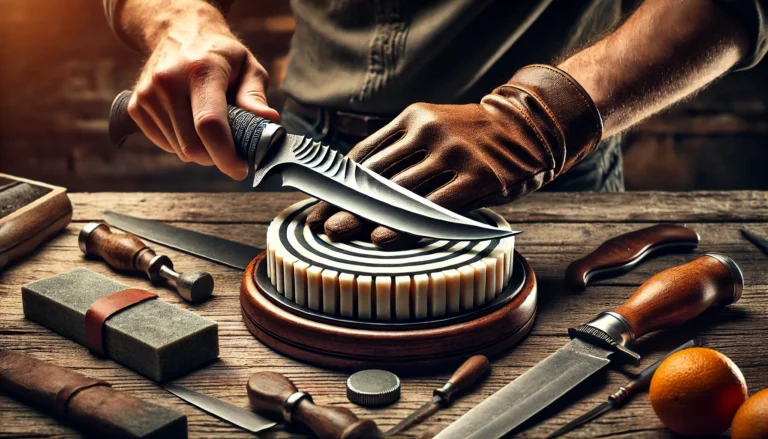
Ever wondered why professional chefs swear by their serrated knives? These versatile kitchen tools might look simple but can transform your cooking experience. In this blog post, we’ll explore the many uses of a serrated knife, its benefits in the kitchen, and why every home cook and culinary enthusiast should have one in their arsenal. From slicing bread to tackling tough vegetables, you’ll soon discover the secret behind this jagged-edge marvel.
What is the Serrated Knife Used For? (Short Answer)
A serrated knife is perfect for cutting bread without squishing it. Its jagged edge is also great for slicing tomatoes and other soft fruits. It can easily cut through hard crusts and skins, making it ideal for melons and citrus fruits. It’s a versatile tool every kitchen needs.
What Makes a Serrated Knife Unique?
A serrated knife stands out due to its saw-like blade. This design allows it to grip and cut through harsh surfaces effortlessly. Unlike straight-edged knives, the serrated edge creates multiple contact points with the food, reducing the force needed to make clean cuts. This unique feature makes it ideal for various kitchen tasks.
Serrated knives are typically longer, enhancing their ability to tackle large items. The length provides better leverage, allowing for smoother cuts. This characteristic is beneficial for cutting through thick bread crusts and large fruits.
Serrated knives often use high-carbon stainless steel for their construction. This ensures durability and maintains sharpness over extended periods. With proper care, a serrated knife can last many years, making it a valuable addition to any kitchen.
Slicing Bread Without Crushing
One of the most common uses for a serrated knife is slicing bread. Bread loaves, especially those with hard crusts, can be challenging to cut with a regular knife. A serrated knife glides through the crust without crushing the soft interior, ensuring perfect slices every time.
Using a sawing motion, you can slice through even the freshest bread without squishing it. This is particularly helpful for homemade bread, where the crust tends to be thicker and more complex. With evenly sliced bread, your sandwiches and toasts will look more appetizing.
Additionally, serrated knives are excellent for cutting pastries and cakes without creating a mess. The gentle sawing action prevents delicate baked goods from crumbling, giving you clean, professional-looking cuts.
Perfecting Tomato Slices
Tomatoes are notorious for being tricky to cut due to their slippery skin and soft interior. A serrated knife handles this task with ease. The serrated edge grips the tomato’s skin, allowing precise cuts without squishing the juicy insides.
You can achieve uniformly thin slices using a serrated knife, perfect for salads, sandwiches, and garnishes. The knife’s design minimizes the risk of accidents, requiring less force to penetrate the tomato’s skin.
For those who enjoy making homemade sauces, a serrated knife can quickly chop tomatoes into small, even pieces. This ensures consistent cooking and enhances the overall texture of your dishes.
Tackling Tough Vegetables
Certain vegetables, like squash and pineapples, have tough exteriors that can be challenging to cut with a straight-edged knife. A serrated knife excels in these situations, making quick work of these tough-skinned veggies.
The knife’s teeth grip the surface, allowing for controlled, effortless cuts. This is particularly useful when preparing butternut squash or melons, where a straight knife might struggle to penetrate the hard rind.
Beyond tough exteriors, a serrated knife also handles delicate vegetables well. For instance, it can slice through bell peppers without crushing them, maintaining their crisp texture for salads and stir-fries.
Preparing Sandwich Ingredients
A serrated knife is a must-have for sandwich lovers. It slices bread perfectly and handles other sandwich ingredients with finesse. A serrated knife ensures clean, precise cuts, from tomatoes and lettuce to deli meats and cheeses.
Even slices are essential for a balanced bite when making sandwiches. A serrated knife effortlessly enhances your creation’s overall presentation and taste.
Additionally, the knife’s versatility extends to spreading condiments. Its thin, jagged edge can double as a spreader for butter, mayo, or mustard, saving you the hassle of switching tools.
Effortless Citrus Peeling
Peeling citrus fruits can be messy, but a serrated knife makes it much more manageable. The knife’s edge cuts through the tough rind without damaging the tender fruit, which is particularly useful for oranges, grapefruits, and lemons.
You can easily peel away the rind and pith by making shallow cuts around the fruit, leaving the juicy segments intact. This method reduces waste and ensures you get the most out of your citrus fruits.
A serrated knife can also create beautiful citrus garnishes for those who enjoy cocktails. Thin slices and twists add a professional touch to your drinks, impressing guests and elevating your presentation.
Safely Cutting Bagels and Rolls
Bagels and rolls often have tough exteriors that can be tricky to slice safely. A serrated knife ensures you get even halves without risking injury. The knife’s teeth grip the surface, preventing slips and accidents.
When cutting bagels, use a gentle sawing motion to avoid crushing the soft interior. This ensures your bagel halves are perfect for toasting and topping with your favorite spreads.
Similarly, the serrated knife excels at slicing through dinner rolls and baguettes. You’ll achieve consistent slices without tearing the bread, enhancing the overall dining experience.
Managing Layer Cakes
A serrated knife is essential for bakers when managing layer cakes. The knife’s long blade and serrated edge allow for clean, even cuts through delicate cake layers without crumbling.
Trim and level each layer with a serrated knife when assembling a layer cake. This ensures a stable, professional-looking cake with even layers of frosting in between.
The knife’s gentle sawing prevents the cake from tearing, making decorating easier. Whether you’re a hobby baker or a professional, a serrated knife is a valuable tool for cake preparation.
Carving Roasts and Poultry
A serrated knife helps carve bread and vegetables, roasts, and poultry. The knife’s teeth grip the meat, allowing precise slices without tearing.
When carving a roast, use a serrated knife to achieve thin, even slices that showcase the meat’s texture and flavor. This is particularly useful for holiday dinners and special occasions.
A serrated knife can easily cut through the skin and joints of poultry, making it easier to serve pieces without making a mess. The knife’s versatility also ensures that it can easily handle various types of meat.
Versatility in the Kitchen
One of the most significant advantages of a serrated knife is its versatility. It can handle many tasks, making it a valuable tool for any home cook or culinary enthusiast.
The serrated knife excels in various kitchen scenarios, from slicing fruits and vegetables to cutting through tough exteriors. Its ability to grip and cut through different textures makes it a go-to tool for many chefs.
Investing in a high-quality serrated knife ensures you have a reliable tool to handle whatever your kitchen throws at you. Its durability and efficiency make it a worthwhile addition to your culinary collection.
Maintaining Your Serrated Knife
Proper maintenance is essential to ensure your serrated knife remains sharp and effective. Unlike straight-edged knives, serrated knives require special care to maintain their unique edge.
Use a honing rod for serrated knives to keep the teeth aligned and sharp. Regular honing prevents the knife from becoming dull and ensures its performance.
Store your serrated knife in a knife block or sheath to protect the blade. Proper storage prevents damage and extends the life of your knife, ensuring it stays in top condition for years to come.
Conclusion:
The serrated knife is a versatile and indispensable tool for any kitchen. Its unique design and capabilities make it ideal for various tasks, from slicing bread to peeling citrus fruits. Incorporating a serrated knife into your kitchen arsenal can enhance your cooking experience and achieve professional-quality results. Whether you’re a home cook, culinary enthusiast, or kitchen gadget lover, a serrated knife is a must-have tool that will elevate your culinary creations. Now that you’ve seen a serrated knife’s many benefits and uses, why not add one to your collection and enjoy the difference it can make in your kitchen?
FAQs
A serrated knife cuts through foods with tough exteriors and soft interiors, such as bread, tomatoes, and citrus fruits. The serrated edge lets the knife grip and slice through these textures without crushing them.
Yes, a serrated knife can cut meat, especially roasts and poultry. Its teeth grip the beef, carving thin, precise slices easier without tearing the flesh.
To maintain a serrated knife, use a honing rod designed for serrated blades to keep the teeth aligned and sharp. Store the knife in a knife block or sheath to protect the blade and prolong its life.
A serrated knife is excellent for peeling citrus fruits. The knife’s edge cuts through the tough rind without damaging the soft fruit, making peeling oranges, grapefruits, and lemons easier.
A serrated knife is versatile and can handle various small kitchen tasks. Its design allows it to perform many functions efficiently, from slicing bagels to spreading condiments.






